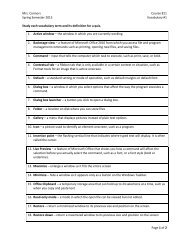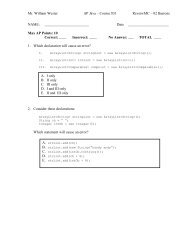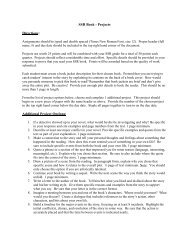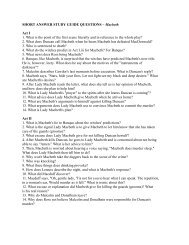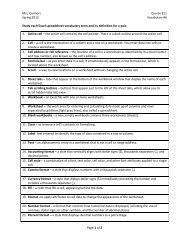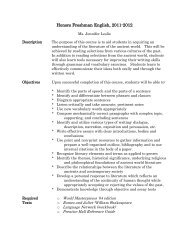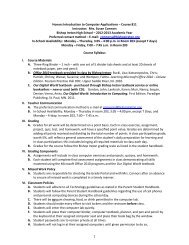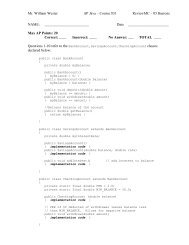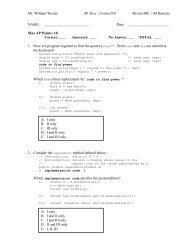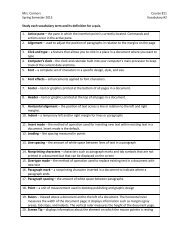Stability Across Cohorts in Divorce Risk Factors - Bishop Ireton High ...
Stability Across Cohorts in Divorce Risk Factors - Bishop Ireton High ...
Stability Across Cohorts in Divorce Risk Factors - Bishop Ireton High ...
You also want an ePaper? Increase the reach of your titles
YUMPU automatically turns print PDFs into web optimized ePapers that Google loves.
344 Demography, Volume 39-Number 2, May 2002<br />
Given the rise <strong>in</strong> the risk of divorce over time, I anticipated that the nature of the <strong>in</strong>teraction<br />
should be a decreas<strong>in</strong>g effect of year of marriage at longer marital durations (because<br />
successive marriage cohorts experience a particular marital duration dur<strong>in</strong>g later periods<br />
when the risk of divorce is greater). The result<strong>in</strong>g model (not shown) does fit the data<br />
better than the basel<strong>in</strong>e model (Model χ 2 = 2,976.54, BIC = –2,770.98). The coefficient<br />
for the <strong>in</strong>teraction between year of marriage and marital duration is statistically significant<br />
(us<strong>in</strong>g the BIC criterion for strong evidence) and negative (e β = .999). This <strong>in</strong>teraction<br />
is consistent with the notion that there is a period <strong>in</strong>fluence on the risk of marital<br />
dissolution. Inclusion of this <strong>in</strong>teraction term does not alter the coefficients (or standard<br />
errors) associated with any of the other covariates. Nor does <strong>in</strong>clud<strong>in</strong>g this <strong>in</strong>teraction<br />
term alter any of the f<strong>in</strong>d<strong>in</strong>gs shown <strong>in</strong> Tables 2 and 3.<br />
How Robust Are the F<strong>in</strong>d<strong>in</strong>gs?<br />
I conducted several sensitivity tests to ascerta<strong>in</strong> whether the results are robust to different<br />
model specifications and restrictions on the data. First, I considered whether different<br />
results would be obta<strong>in</strong>ed if I coded age at marriage and year of marriage as a series of<br />
dummy variables <strong>in</strong>stead of us<strong>in</strong>g cont<strong>in</strong>uous variables. Because of the number of potential<br />
<strong>in</strong>teractions, I estimated a separate model for each <strong>in</strong>teraction between a particular<br />
age at marriage and year of marriage (us<strong>in</strong>g the age at marriage and year of marriage<br />
categories represented <strong>in</strong> Table 1). These models do not reveal a pattern of <strong>in</strong>teraction<br />
between age at marriage and year of marriage that is otherwise masked by us<strong>in</strong>g cont<strong>in</strong>uous<br />
variables (see Appendix).<br />
Second, I considered the possibility that the results may be biased somehow by the<br />
fact that women who marry <strong>in</strong> earlier historical periods are more heavily weighted toward<br />
earlier ages at marriage. To address this issue, I reconfigured the sample and reestimated<br />
the models us<strong>in</strong>g data on marriages formed after 1959. I also formed a sample based on<br />
all years of marriage but restricted marriages to those formed before age 23, yield<strong>in</strong>g a<br />
sample <strong>in</strong> which the maximum age at marriage is consistent across year of marriage. For<br />
the sample restricted to women who marry before age 23, accord<strong>in</strong>g to values of the BIC<br />
statistic, the same <strong>in</strong>teraction as revealed <strong>in</strong> Table 2 yields a better model fit: the <strong>in</strong>teraction<br />
of be<strong>in</strong>g black with year of marriage (see Appendix). The coefficients from this model<br />
are similar to those estimated from the full sample.<br />
In the sample restricted to marriages formed after 1959, the <strong>in</strong>teraction between be<strong>in</strong>g<br />
black and marriage cohort yields weak evidence of a better-fitt<strong>in</strong>g model. The important<br />
po<strong>in</strong>t to note from models estimated on this sample, though, is that no new <strong>in</strong>teractions<br />
appeared when a different set of marriage ages was used. The lack of a substantial<br />
<strong>in</strong>teraction between be<strong>in</strong>g black and year of marriage attests to the need for a long historical<br />
sequence to detect substantial changes <strong>in</strong> the risk of divorce.<br />
Does Cohabitation Make a Difference?<br />
One substantial change <strong>in</strong> the nature of <strong>in</strong>timate relationships has been the sudden and<br />
steep rise <strong>in</strong> the <strong>in</strong>cidence and prevalence of premarital cohabitation (Bumpass and Sweet<br />
1989). Much research has l<strong>in</strong>ked premarital cohabitation to an <strong>in</strong>creased risk of marital<br />
dissolution (Ax<strong>in</strong>n and Thornton 1992; Bumpass, Sweet, and Cherl<strong>in</strong> 1991; DeMaris and<br />
MacDonald 1993; Mann<strong>in</strong>g and Smock 1994; Thomson and Colella 1992). In this section,<br />
I seek to answer two questions. First, has the effect of premarital cohabitation on<br />
divorce changed over time? Second, are the relationships between the measured covariates<br />
and divorce somehow altered by the substantial <strong>in</strong>crease <strong>in</strong> premarital cohabitation<br />
over the past several decades?<br />
I made use of <strong>in</strong>formation on premarital cohabitation conta<strong>in</strong>ed <strong>in</strong> rounds 4 and 5 of<br />
the NSFG, exam<strong>in</strong><strong>in</strong>g marriages formed after 1964. I replicated the models shown <strong>in</strong><br />
Table 2, first us<strong>in</strong>g premarital cohabitation as a predictor variable and then exclud<strong>in</strong>g




